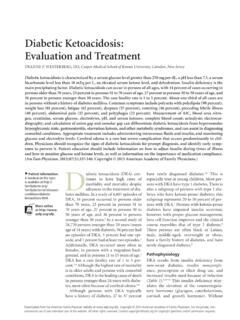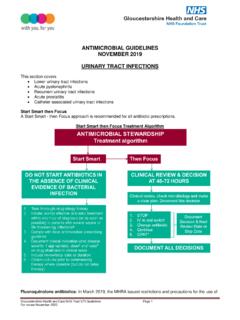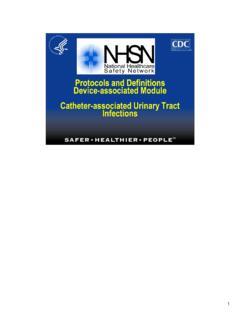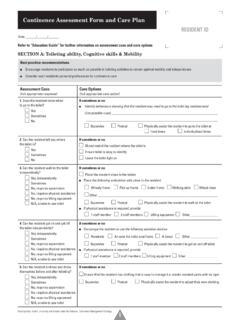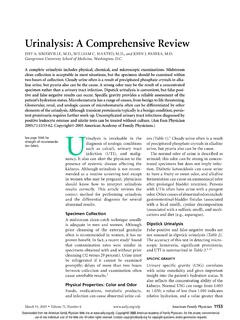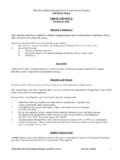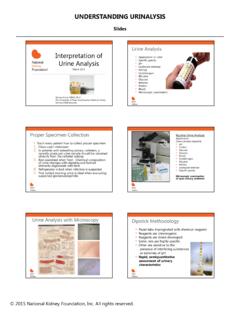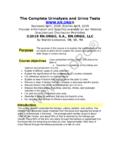Transcription of CHAPTER 8 LABORATORY SERVICES - WHO
1 OPERATIONS MANUAL FOR STAFF AT PRIMARY HEALTH CARE CENTRES l 165 CHAPTER 8 LABORATORY SERVICES INTRODUCTIONL aboratory (lab) SERVICES form an essential component of HIV SERVICES . It is important to know how to collect specimens and perform tests correctly in order to obtain correct results. Regular quality management is important. Th e lab space will need to be large enough for all the equipment and staff required for the SERVICES . Patients need to be counselled to help them understand what the tests are for, how they will be performed and the meaning of the results. To do all of this, you will need to make sure that you follow steps provided in this CHAPTER . Lab SERVICES must be consistent and dependable to correctly assess and manage patients with various illnesses.
2 Without good quality lab SERVICES , test results may be wrong, and if they are not currently accurate, consistent, and dependable, every eff ort should be made to raise them to an acceptable standard. Good communication is very important in your health centre and also in your lab. Talk regularly with staff working there to make sure that processes are followed correctly and that results are accourate. For lab tests that are not performed at the health centre, it is important that your staff have good communication with the district hospital lab or other referral lab. 166 l CHAPTER 8 l LABORATORY SERVICESTh is CHAPTER provides the information you will need to set up a lab in your centre, as well as guidelines and steps on how to use various tests, read diff erent test results and assure quality of SERVICES .
3 With guidelines on how to build and run a lab, your centre will be able to provide consistent and dependable lab SERVICES for your patients. In addition, job aids and standard operating procedures (SOPs) are provided and can be made available to be easy to see and use. A job aid is a simple tool that helps a worker do his or her job (for example, step-by-step instructions on how to do a test, oft en with pictures). Job aids generally provide quick reference information rather than in-depth training. Th ey are a storage place for information other than your memory that you can use to help you do your job. Th ese should be posted on a wall near where the testing is done. An SOP is a prescribed written procedure to be followed routinely in doing a task.
4 In the case of the lab, these describe in detail what a person doing specimen collection, testing, recording of results or other necessary lab e CHAPTER assumes that your lab at the health centre forms part of the national LABORATORY system. Th is system includes the district hospital lab that provides those tests not available at your centre. It also assists in quality assurance and sends specimens on to higher level labs at the provincial or national level for more complex lab tests. Please note that this Operations Manual assumes your centre has some electricity and ESSENTIAL LAB SERVICESE ssential lab SERVICES are the minimum lab tests that should be done at your centre to off er comprehensive HIV SERVICES they are not available directly at your health centre they should be available at your district hospital lab.
5 You may be able to send the specimens you have collected from your patients or you may need to send the patient to the district hospital lab for these tests. Th is process and type of tests to be sent to level II should be clearly defi ned with your district hospital lab before you MANUAL FOR STAFF AT PRIMARY HEALTH CARE CENTRES l 167 ESSENTIAL LAB TESTS AVAILABLE AT HEALTH CENTREADDITIONAL ESSENTIAL LAB TESTS THAT CAN BE DONE AT YOUR DISTRICT HOSPITALHIV diagnostics Rapid HIV antibody tests (fi rst and second tests) Infant diagnosis; preparation of dried blood spot (DBS) out for virological testingHaematologyHaemoglobin determinationVenous whole blood collection and send-out for CD4 cell absolute count and for percentageBlood sugar (glucose)TB diagnostics: Sputum send-out for smear microscopy (or on-site acid fast bacilli (AFB) smear microscopy) Sputum send-out for culture and drug susceptibility testingMalaria diagnostics (if in endemic area): Peripheral blood smear (PBS) preparation and smear microscopy or Rapid test to detect and discriminate between Plasmodium falciparum and mixed Plasmodium speciesSyphilis diagnostics: Rapid syphilis test Rapid plasma regain if refrigeration (RPR)Pregnancy test.
6 Rapid test for pregnancyUrine dipstick for sugar and proteinHIV diagnostics Rapid HIV antibody tests (fi rst, second and third tests)CD4 absolute count and percentageFull blood count with differential TB diagnostics Acid fast bacilli (AFB) smear microscopy Sputum send-out for culture and drug susceptibility testing Serum alanine aminotransferase (ALT)Serum creatinine and blood urea nitrogenGram stainSyphilis - rapid plasma reagin (RPR) and TPHAB asic cerebrospinal fl uid (CSF) and urine microscopyBilirubin determination for neonatesBlood and sputum cultures (send out)Cryptococcal antigen and/or India inkLactic acid Type and cross-match for transfusionPulse oximetryChest X-ray 168 l CHAPTER 8 l LABORATORY LAB SAFETYYour health centre staff will need to know how to safely use lab supplies and collect, test, and transport specimens.
7 See CHAPTER 9 the Human Resources for information on standard lab precautions, injection safety, post-exposure procedures, and TB infection control. See CHAPTER 5 the Infrastructure for information on safe water, sanitation, hygiene, waste management, and power. Bio-safety guidelines: Treat all specimens (blood, urine, sputum, etc) as potentially infectious. Wear protective gloves and a lab gown while drawing blood and handling specimens. Do not, eat, drink, or smoke in the lab. Do not keep food in the lab refrigerator. Do not wear open toe footwear in the lab. Clean up spills with an appropriate disinfectant, 1% bleach. Decontaminate all instruments and materials with an appropriate disinfectant. Dispose of all waste, including test kits, in a biohazard safetyInjuries may occur when drawing blood or using a fi nger stick or heel stick to obtain a blood specimen, or testing with sharps (blood collection needles, lancets, cutting blades, glass pipettes or slides, broken plastic or glass, etc.)
8 When possible, use single-use vacuum blood collection tubes with safety needles rather than a syringe and needle. Th is also reduces the amount of biological waste. OPERATIONS MANUAL FOR STAFF AT PRIMARY HEALTH CARE CENTRES l 169 Sharps disposal All sharps should be placed in a puncture-resistant, leak proof, sharps disposal container. Follow the disposal instructions in CHAPTER 5 Infrastructure. Th e CHAPTER 9 Human Resources also has instructions on safe handling of needles and syringes, and what to do if a needle stick injury occurs. If possible, only use vacuum tubes and a needle to draw blood (instead of syringe and needle). DO NOT recap, bend, break, or manipulate needles by hand. Th row these items away intact.
9 Aft er you use sharps, put them in a puncture-resistant, leak-proof trash container right away. DO NOT place sharps in regular trash containers. Report all injuries involving sharps to the (person in charge of safety) at your centre or at the district level. Post-exposure prophylaxis (PEP)PEP is the use of ARV drugs to reduce the risk of HIV infection following accidental exposure. PEP should be available for all staff members following exposure of non-intact skin (through percutaneous sharps injury or skin abrasion) or mucous membranes (through sexual exposure or splashes to the eyes, nose or oral cavity) to a potentially infected body fl uid from a source that is HIV-positive or has unknown HIV statusPEP includes: a staff person trained to provide prompt clinical advice.
10 And access to antiretrovirals (drugs to prevent HIV infection) as soon as possible aft er exposure and within 72 CHAPTER 9, the Human Resources for more l CHAPTER 8 l LABORATORY LAB TESTINGS pecimen testing has three parts:PART 1: Before performing the test Specimen collection: Collect the specimen or give clear instructions when the patient is to collect the specimen themselves (urine and sputum). Record keeping: Review the requisition forms to ensure that all necessary information is recorded. Enter the required information from the requisition form into the lab logbook1. Fill out lab worksheets for the tests that will be run that day. If specimens are to be sent to another lab for testing, store the specimens properly until they are sent-out.










